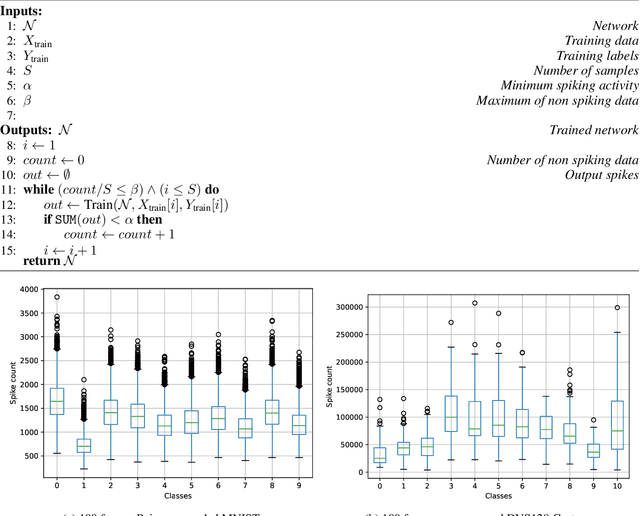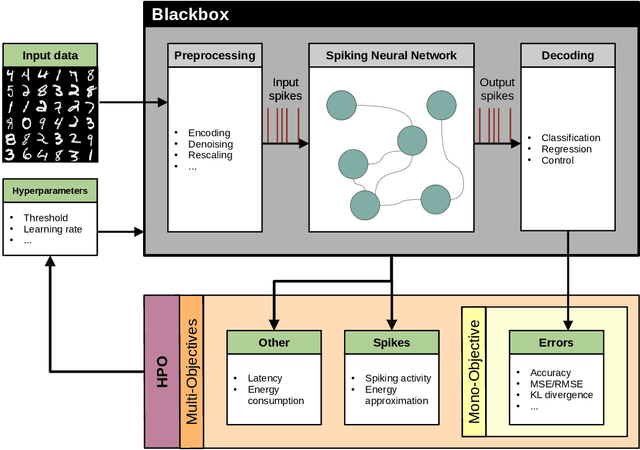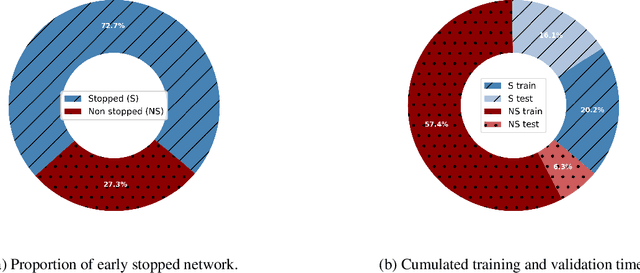Pierre Boulet
Parallel Hyperparameter Optimization Of Spiking Neural Network
Mar 01, 2024



Abstract:Spiking Neural Networks (SNN). SNNs are based on a more biologically inspired approach than usual artificial neural networks. Such models are characterized by complex dynamics between neurons and spikes. These are very sensitive to the hyperparameters, making their optimization challenging. To tackle hyperparameter optimization of SNNs, we initially extended the signal loss issue of SNNs to what we call silent networks. These networks fail to emit enough spikes at their outputs due to mistuned hyperparameters or architecture. Generally, search spaces are heavily restrained, sometimes even discretized, to prevent the sampling of such networks. By defining an early stopping criterion detecting silent networks and by designing specific constraints, we were able to instantiate larger and more flexible search spaces. We applied a constrained Bayesian optimization technique, which was asynchronously parallelized, as the evaluation time of a SNN is highly stochastic. Large-scale experiments were carried-out on a multi-GPU Petascale architecture. By leveraging silent networks, results show an acceleration of the search, while maintaining good performances of both the optimization algorithm and the best solution obtained. We were able to apply our methodology to two popular training algorithms, known as spike timing dependent plasticity and surrogate gradient. Early detection allowed us to prevent worthless and costly computation, directing the search toward promising hyperparameter combinations. Our methodology could be applied to multi-objective problems, where the spiking activity is often minimized to reduce the energy consumption. In this scenario, it becomes essential to find the delicate frontier between low-spiking and silent networks. Finally, our approach may have implications for neural architecture search, particularly in defining suitable spiking architectures.
Multi-layered Spiking Neural Network with Target Timestamp Threshold Adaptation and STDP
Apr 03, 2019



Abstract:Spiking neural networks (SNNs) are good candidates to produce ultra-energy-efficient hardware. However, the performance of these models is currently behind traditional methods. Introducing multi-layered SNNs is a promising way to reduce this gap. We propose in this paper a new threshold adaptation system which uses a timestamp objective at which neurons should fire. We show that our method leads to state-of-the-art classification rates on the MNIST dataset (98.60%) and the Faces/Motorbikes dataset (99.46%) with an unsupervised SNN followed by a linear SVM. We also investigate the sparsity level of the network by testing different inhibition policies and STDP rules.
Unsupervised Visual Feature Learning with Spike-timing-dependent Plasticity: How Far are we from Traditional Feature Learning Approaches?
Jan 14, 2019



Abstract:Spiking neural networks (SNNs) equipped with latency coding and spike-timing dependent plasticity rules offer an alternative to solve the data and energy bottlenecks of standard computer vision approaches: they can learn visual features without supervision and can be implemented by ultra-low power hardware architectures. However, their performance in image classification has never been evaluated on recent image datasets. In this paper, we compare SNNs to auto-encoders on three visual recognition datasets, and extend the use of SNNs to color images. Results show that SNNs are not competitive yet with traditional feature learning approaches, especially for color features. Further analyses of the results allow us to identify some of the bottlenecks of SNNs and provide specific directions towards improving their performance on vision tasks.
 Add to Chrome
Add to Chrome Add to Firefox
Add to Firefox Add to Edge
Add to Edge